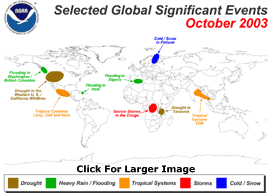Major Highlights
NOAA REPORTS MUCH OF US WARMER THAN AVERAGE IN OCTOBER
OCTOBER GLOBAL TEMPERATURE IS THE WARMEST ON RECORD
Many western states had record or near-record warmth in October, while temperatures in the eastern third of the country were near average or cooler than average. It all added up to a much warmer than average October for the U.S., according to scientists at the National
Oceanic and Atmospheric Administration's (NOAA) National Climatic Data Center (NCDC) in
Asheville, N.C. Anomalously warm temperatures also occurred in many other areas of the
world, and the average global temperature was the warmest on record for October. NOAA is an agency of the U.S. Department of Commerce.
NOAA scientists report that the average temperature for the contiguous United States in
October (based on preliminary data) was 57.0°F (13.9°C), which was 2.3°F (1.3°C) above the
1895-2003 mean. The October mean temperature in Nevada and California was the warmest on record, and ten other western states were much warmer than average. The average
October temperature in Alaska was also much warmer than average, 6.4°F (3.6°C) above the
1971-2000 mean. Conversely, significantly cooler than average temperatures occurred in eight
midwestern and eastern states from Indiana to Massachusetts.
Drier than average conditions affected many states from the West Coast to the central
United States and parts of the Southeast. The only states with significantly wetter than average
conditions were Washington and twelve states along the eastern seaboard. The cooler and wetter than average conditions in the East along with warmer and drier than average conditions
from the central to the western United States are part of a pattern that has persisted for many
months. The most recent six-month period (May-October) was the wettest on record in the
Northeast and second wettest in the Southeast and Central regions, while five regions from the
East North Central to the West were drier or much drier than average.
The combination of above average temperatures and below average precipitation led to
moderate to extreme drought in 42% of the contiguous United States at the end of October, based on the Palmer Drought Index, a widely used measure of drought. Drought conditions
have persisted for much of the past four to five years in parts of the West. Impacts of the
cumulative effects of warm and dry conditions include below average reservoir levels, poor
range and pasture conditions, tree die-off in many forested regions, and conditions favorable for
wildfire development. Although fewer acres have been consumed by wildfire in 2003 than in the preceding year, dry conditions in southern California contributed to some of the most costly and
deadly wildfires ever experienced with more than 475,000 acres burned in late October, according to the National Interagency Fire Center.
Globe:
The average global surface temperature for combined land and ocean surfaces during
October 2003 (based on preliminary data) was 1.27°F (0.7°C) above the 1880-2002 long-term
mean, and was the warmest October since the beginning of reliable instrumental records in 1880. The January-October year-to-date temperature was the third warmest, slightly cooler
than 1998 and 2002.
October monthly temperatures were more than 4°F (2.2°C) above average across much of Canada, Alaska, and the western United States, and above average temperatures also
covered large parts of Asia and Africa. The most widespread areas of cooler than average temperatures were in Europe and southern Australia. The global ocean surface temperature
was warmest on record, and temperatures in much of the equatorial Pacific were above the
1971-2000 average. Evolving conditions in the equatorial Pacific point toward a possible return of weak El Niño conditions by the end of November, according to the Climate Prediction Center
(see NOAA press release http://www.noaanews.noaa.gov/stories2003/s2117.htm)
NOAA Environmental Satellites, Data and Information Service is the nation's primary
source of space-based meteorological and climate data. It operates the nation's environmental
satellites, which are used for weather forecasting, climate monitoring and other environmental
applications such as fire detection, ozone monitoring and sea surface temperature
measurements.
NOAA Environmental Satellites, Data and Information Service also operates three data
centers, which house global data bases in climatology, oceanography, solid earth geophysics,
marine geology and geophysics, solar-terrestrial physics, and paleoclimatology. To learn more
about NOAA Environmental Satellites, Data and Information Service, please visit
http://www.nesdis.noaa.gov.
NOAA is dedicated to enhancing economic security and national safety through the
prediction and research of weather and climate-related events and providing environmental
stewardship of the nation's coastal and marine resources. To learn more about NOAA, please
visit: http://www.noaa.gov.

Report Index

 United States
Paleoclimate (Pre-Instrumental) Perspective United States
Paleoclimate (Pre-Instrumental) Perspective

 Top of Page Top of Page
 NCDC / Climate Monitoring / Climate of 2003 / October / Search / Help NCDC / Climate Monitoring / Climate of 2003 / October / Search / Help
http://www.ncdc.noaa.gov/oa/climate/research/2003/oct/oct03.html
Downloaded Sunday, 21-Sep-2008 07:59:11 EDT
Last Updated Friday, 18-Nov-2005 14:12:17 EST by Candace.Tankersley@noaa.gov
Please see the NCDC Contact Page if you have questions or comments.
|
 NCDC / Climate Monitoring / Climate of 2003 / October / Search / Help
NCDC / Climate Monitoring / Climate of 2003 / October / Search / Help
 National Overview
National Overview
 United States Drought
United States Drought
 United States
Paleoclimate (Pre-Instrumental) Perspective
United States
Paleoclimate (Pre-Instrumental) Perspective

 Top of Page
Top of Page NCDC / Climate Monitoring / Climate of 2003 / October / Search / Help
NCDC / Climate Monitoring / Climate of 2003 / October / Search / Help


